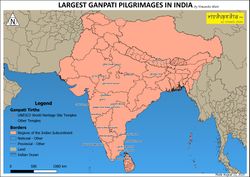Ganpatya
From Hindupedia, the Hindu Encyclopedia
Ganapatya is the religious sect that primarily worships Ganapati, the person of the Matang-Guhyak gotra who led the Devas to victory in wars against Asuras. He is shown elephant-headed, as are others of this gotra, and he was the son of Siva and Parvati. While Ganapati worship is done in all the major traditions, the Ganapatya religious sect treats Ganapati as the Supreme Godhead, Akshara Brahman. Besides the Veda and Saiva Puranas, the main scriptures followed by Ganapatya-s are the Ganapatya Agama-s. The religion is most prevalent in Maharasthra.

